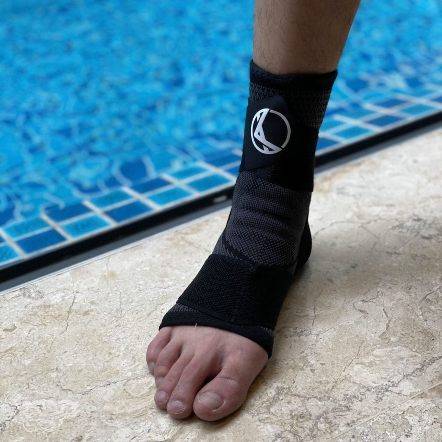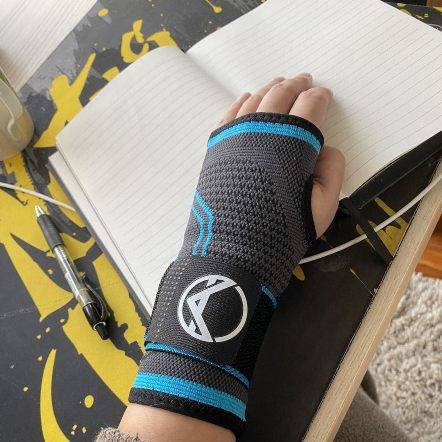
NOVEMBER 29, 2023 | 3 Mins Read
TABLE OF CONTENTS
Knee pain while running? It's a common dilemma many runners and athletes face. You don't want to push through the pain, but you also don't want to take a break from your exercise routine. Knee injuries can sideline even the most experienced runners, and preventive measures are essential for staying in the game.
In this article, we'll dive deep into the importance of a knee brace for running. From the different types of knee braces to important features to consider, we'll help you make an informed decision so you can hit the ground running with confidence.

Knee braces are an invaluable piece of compression garment for runners and joggers alike. While many focus solely on finding the right shoes and apparel, compression sleeve brace for running provides a host of benefits that can take your performance to the next level. Here are some advantages:
If you have an existing knee injury, wearing a knee brace can help. A knee brace serves several purposes:
Increased knee joint stability and support are crucial for activities like running. Wearing knee sleeves while running can significantly enhance this stability. Here's how it works:
Improved blood flow and circulation are crucial for muscle health, especially when dealing with injuries or during intense physical activities. Compression sleeves play a vital role in this process. Here's how they work and their benefits:
Enhanced performance and endurance can be significantly aided by using knee compression sleeves. These sleeves work in a few key ways:
Preventing injuries and the risk of re-injury is crucial, especially for runners. Wearing a knee brace during running is a proactive step in this direction. Here's how a knee brace can be beneficial:
These are just a few of the many advantages backed by a 2016 study, which determined that wearing compression sleeves resulted in improved running economy and performance, including extended time to exhaustion, reduced perceived exertion and blood lactate levels, and greater peak leg muscle power post-run. Furthermore, it was also revealed that the use of compression gear might even reduce indicators of inflammation and muscular damage.
To understand how knee compression sleeves work, it is important to know that three bones form the knee joint structure; your thighbone (femur), shinbone (tibia), and kneecap (patella). Connecting these bones together is a network of ligaments that allow us to move our legs in multiple directions with stability.
When we put a strain on our knees through any type of physical activity including running or jogging, we unknowingly place immense pressure on each individual part forming this complex mechanism. Without proper support from quality gear such as knee compression sleeves, we may cause lasting injury due to misalignment from forceful impact or overuse if not regularly taking breaks while exercising.
This brings us back to why they are beneficial; Knee Compression Sleeves help enhance circulation throughout all parts of your leg by providing an extra level of stability around your patella as well as strengthening supporting muscles surrounding it like hamstrings & calves.
A study of male runners in 2018 showed that those who wore a compression garment and ran a 5k time trial had less performance decrease and even better overall performance in the subsequent 5k one hour later compared to those who didn't wear them during the first run.

Choosing the right knee compression sleeves for running and jogging involves understanding the different types available and identifying which best suits your needs. Here's a straightforward guide:
Knee sleeves come in various designs and levels of support. Some offer more compression, while others focus on flexibility. It's essential to know the difference to match the sleeve to your specific requirements.
Once you've chosen the best-fitting sleeve, remember these few tips to ensure the highest comfort and benefits from wearing it:
Discover the best compression sleeves in the market for your running and jogging endeavors with Koprez® compression sleeves. Our products stand out in the market, offering unparalleled comfort, stability, and breathability. Designed to conform seamlessly to your body, our sleeves ensure a snug, comfortable fit without the inconvenience of bunching or pinching during exercise. Choose Koprez® for an enhanced exercise experience, and make each workout session more effective and enjoyable. Shop with us today and elevate your running routine!
Author

Claire Evans worked as the content marketing manager at Koprez. Claire combined a background of writing and editing, marketing, and patient education to best serve consumers, fitness enthusiasts, athletes, and anyone who relies on the Koprez brand for helpful information.
Koprez® Featured Products


"I sprain my wrist super often, so I decided to try out this sleeve. This is game-changing! I've been using it for a while now, and my wrists feel amazing. I haven't gotten in any injuries since using it too. It just makes my wrists feel so supported."
Alexis A.


"Use this for my boxing training. It is a very comfortable brace and does not move out of position during skipping ropes and sparring sessions. I use it while running too. Probably the best brace I've purchased throughout the years. It is very flexible. Makes me look like a pro! :)"
Samuel L.


"I've just got back to running after a couple of years of being plagued by injury. These compressions socks are helping give me peace of mind while I build up my distance again. They are the perfect level of compression, super comfy, and very high quality. Feel great while on a run, and looks great in the orange colour I have!"
Dave R.


"I have a weak ankle, and the Koprez ankle sleeve has been a lifesaver. Wear it every day. Super breathable and comfortable. Like wearing a cool sporty looking sock!"
James F.


"This is the best knee sleeve I've ever tried. It's now a must-have for all my exercises. A few years ago, I had an accident that damaged my knees, but with Koprez I can be active again with no knee pains at all. It's been truly amazing!"
Alex M.


"One of the best purchases I've ever made. It fits your legs all the way from top to bottom, great snug fit, gives you support and definitely helps during rehab and training."
Rafael A.


"I had a minor elbow injury, and Koprez sleeve was super supportive and definitely helped me recover faster. I still use the sleeve to prevent further injury. So far, so good. Very comfortable and does not feel hot at all. Highly recommend!"
Corey B.


"It's really been a game-changer for me. It allows me to exercise a lot longer than I used to. Now my knees don't hurt, and they're not uncomfortable at all."
Mike P.


"Great product!!"
Harold


"I have carpal tunnel, and this brace has helped me work pain-free. Love the materials, and I can feel my wrists slowly getting better, even when I don't wear them!"
Christopher J.


"I wanted to try out these sleeves to improve my squats and deadlift in the gym without worrying about injuring my knees. They stayed up throughout the entire gym session, and my knees feel super supported. Now I can do what I love for years to come. "
Corbin C.